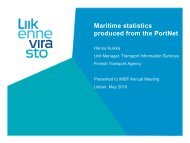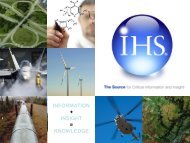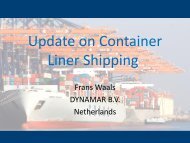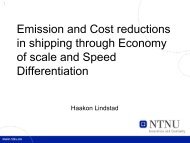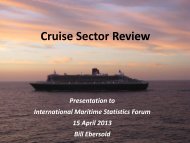Andrea Hernandez - Wartsila - IMSF
Andrea Hernandez - Wartsila - IMSF
Andrea Hernandez - Wartsila - IMSF
Create successful ePaper yourself
Turn your PDF publications into a flip-book with our unique Google optimized e-Paper software.
International Maritime Statistics Forum<br />
Hong Kong, 31st May 2011
Disclaimer<br />
This release includes various forward-looking statements regarding<br />
potential risks, conditions and Wärtsilä’s business, as assumed by<br />
Wärtsilä Corporation as of the date of this release. The forward-looking<br />
statements are based on unclear and unknown factors, risks, events and<br />
uncertainties beyond Wärtsilä’s control. Accordingly, the forward-looking<br />
statements may or may not materialise, or may materialise substantially<br />
differently. Consequently, neither Wärtsilä Corporation nor any of its<br />
subsidiaries assume liability on the basis of, or related to, this release.<br />
The readers of this release must not rely on, take, or fail to take any<br />
actions based on this release or contents thereof. Wärtsilä Corporation<br />
undertakes no obligation to update or adjust this release.<br />
2
Agenda<br />
Scenarios:<br />
Why, what and how<br />
Three scenarios<br />
• Rough Seas<br />
• Yellow River<br />
• Open Oceans<br />
Summary<br />
3
Scenarios<br />
Scenarios are<br />
• Stories describing alternative, plausible futures and how they might<br />
come about<br />
• A method of making sense of a complex and changing environment<br />
• A valuable tool for enhancing strategic decision-making by challenging<br />
conventional modes of thinking<br />
4
Introduction<br />
To support our strategy work and provide a foundation for finding<br />
ways of being prepared for the future, together with the industry.<br />
Three challenging and different, yet plausible, scenarios about what<br />
shipping could look like in the year 2030.<br />
By combining expert input, quality research, hard work, dedication<br />
and a bit of imagination.<br />
5
The framework<br />
• Time horizon<br />
• What could shape the<br />
future: uncertainties<br />
and certainties<br />
• Two certainties:<br />
– Shipping will continue<br />
to be part<br />
of the transportation<br />
matrix<br />
– Fresh water will<br />
become more<br />
valuable<br />
• And a large number of<br />
uncertainties<br />
Energy<br />
Social values<br />
Technology<br />
Geopolitics<br />
International finance<br />
Legislation<br />
Investors<br />
Macroeconomics<br />
Suppliers<br />
Competitors<br />
Employees<br />
Shipping industry<br />
player<br />
Globalisation<br />
Environment<br />
NGOs<br />
Customers<br />
Regulators<br />
Climate<br />
Demographics<br />
Trade<br />
6
Key uncertainties lay the groundwork for scenarios<br />
The key uncertainties<br />
refined into five<br />
dimensions:<br />
1<br />
2<br />
3<br />
4<br />
5<br />
Trade and economic<br />
growth<br />
Response to climate<br />
change and<br />
sustainability issues<br />
Geopolitical issues<br />
and global leadership<br />
Solutions to deal with<br />
scarcity issues<br />
Control of power<br />
Neo-colonialistic<br />
approach creates<br />
friction<br />
National<br />
governments<br />
control power<br />
Protectionistic,<br />
bilateral, uneven<br />
growth<br />
1<br />
Local means to deal<br />
with sustainability<br />
issues<br />
Scrambled<br />
geopolitics<br />
2<br />
3<br />
4<br />
Global leadership<br />
by China<br />
Global action<br />
against climate<br />
change<br />
5<br />
Free trade and<br />
flow of capital,<br />
strong growth<br />
Megacities and<br />
mega corporations<br />
form the power<br />
base<br />
Technological<br />
or market-driven<br />
solutions<br />
7
Three scenarios<br />
• Scarcity of resources is predominant<br />
• Climate change adds further stress<br />
• Cartels and bilateral agreements have overtaken free markets<br />
• Wealth is divided unequally among nations, resulting in tension<br />
• China dominates the global arena<br />
• Resource-intensive manufacturing has moved to Africa<br />
and other Asian countries<br />
• Economic growth is significantly slower in the West<br />
• Climate change is tackled only on a regional level – no global<br />
agreements exist<br />
• Global mega-corporations and megacities have gained<br />
power over the nation states<br />
• Governments cooperate on the governance of climate<br />
issues and free trade protocols<br />
• Climate change is perceived as an opportunity and<br />
innovating green solutions is a lifestyle<br />
8
The first convoy of ships<br />
carrying water sails from<br />
Russia to India, protected<br />
by Navy escorts.<br />
Rough Seas
Causes and effects<br />
Water and<br />
food scarcity<br />
Energy<br />
scarcity<br />
Friction<br />
GDP growth<br />
Relocation<br />
of industrial<br />
activities and<br />
new trade<br />
patterns<br />
Bilateral<br />
agreements and<br />
protectionism<br />
Self-sustained<br />
communities<br />
positive impact<br />
negative impact<br />
10
Rough Seas<br />
In the world of Rough Seas, scarcity of energy, water and food is<br />
predominant. Climate change adds further stress.<br />
• Logistics chain optimised regionally<br />
• Fleets partly nationalised<br />
• Changed goods flow, reduced container traffic<br />
• New trade routes<br />
• Increased need for armed escorts<br />
11
Water carrier for the Rough Seas<br />
Water is valuable and is in short supply water is transported<br />
Energy scarcity<br />
• Consumption of natural resources should be minimized<br />
• Ships will contain technology to reduce energy<br />
consumption<br />
Dwt<br />
Length<br />
Breadth<br />
Draft<br />
150 000 dwt<br />
285 m<br />
46 m<br />
16 m<br />
12
Water carrier for the Rough Seas<br />
Flettner rotors<br />
to harness the wind energy<br />
Streamlined deckhouse<br />
LNG tanks on deck<br />
Multi fuel engines<br />
Air lubrication<br />
to reduce frictional resistance<br />
Fish tail propulsion<br />
13
A Chinese containership – one of<br />
many – is crossing the Indian<br />
Ocean on its way from Dar es<br />
Salaam to Shanghai, loaded with<br />
manufactured goods.<br />
Yellow River
Causes and effects<br />
Growth in<br />
Chinese<br />
economy<br />
Relative<br />
slowdown in<br />
Western<br />
economies<br />
Strong<br />
internal<br />
consumption<br />
and intra-Asian<br />
trade<br />
Alliances<br />
create Chinese<br />
“satellite states”<br />
especially in<br />
Africa<br />
Shift in<br />
balance of<br />
power<br />
positive impact<br />
negative impact<br />
Challenges in<br />
governance within<br />
the Chinese sphere<br />
of influence<br />
Measures to<br />
counterbalance<br />
Chinese<br />
growth<br />
15
Yellow River<br />
In Yellow River, China dominates the global arena, economically,<br />
geopolitically and in shipping.<br />
• Most big shipping companies Chinese-owned<br />
• New ports in Africa, Eastern Russia and India<br />
• Chinese ports sophisticated logistics centres<br />
• Manufacturing to Africa and other Asian countries<br />
• Chinese energy demand counterbalanced with efficiency and cleantech<br />
• Western societies adapt sustainable living<br />
16
Box carrier for Yellow River<br />
Large trade volumes of produced goods from Africa to China<br />
• Shipping is increasingly important for China<br />
• China controls and influences entire transport<br />
chains possibility to generate new transport standards<br />
– Larger cargo units for higher transport efficiency<br />
Capacity<br />
Length<br />
Breadth<br />
Draft<br />
1 000 MBEU<br />
400 m<br />
58 m<br />
14.5 m<br />
17
Box carrier for Yellow River<br />
Larger cargo units: Mega Box<br />
1 000 MBEU = 8 000 FEU = 16 000 TEU<br />
Rim drive propulsion<br />
DF aux engines<br />
Optional Nuclear power<br />
Long waterline<br />
Cargo ramp<br />
Cargo hold can be loaded<br />
simultaneously with the cargo<br />
deck. Flexibility and speed.<br />
18
The world’s first floating<br />
desalination unit, powered<br />
entirely with renewable<br />
energy, is launched to serve<br />
the city of Mumbai.<br />
Open Oceans
Causes and effects<br />
Protection of<br />
commercial<br />
interests<br />
GDP growth<br />
Agreements<br />
on climate and<br />
trade<br />
Growth<br />
of global<br />
corporations<br />
Growth of<br />
megacities<br />
positive impact<br />
negative impact<br />
Governments<br />
focus on<br />
corporate<br />
governance<br />
Technology for<br />
efficiency and<br />
sustainability<br />
20
Open Oceans<br />
The world of Open Oceans is a strongly globalized one.<br />
Global mega-corporations boost GDP growth and megacities have<br />
gained power over the nation state.<br />
• Shipping a component within optimised and integrated logistic systems<br />
• Ships simply tools in the process<br />
• Goods transported between megacities and areas rich in resources<br />
• New types of vessels developed based on environmental challenges<br />
• Climate change an opportunity, lifestyle green<br />
• Governments cooperate on climate issues and free trade protocols<br />
• Sustainable cruise vacations a growing trend<br />
21
Algae harvesting vessel for Open Oceans<br />
Climate change is perceived as an opportunity and innovating green<br />
solutions is a lifestyle new green technology is introduced<br />
• Algae is used to produce bio fuels<br />
new ships are needed<br />
• Environmentally friendly operation is required<br />
Length<br />
Breadth<br />
Draft<br />
100 m<br />
20 m<br />
6 m<br />
22
Algae harvesting vessel for Open Oceans<br />
Large booms are used to enlarge<br />
the surface area processed<br />
Algae is collect into barges<br />
Barges are collected with tugs<br />
and replaced with new ones<br />
Algae is filtered from the sea water<br />
The Algae harvester skims trough the water surface to collect algae<br />
that is growing in large basins in the ocean<br />
23
Algae harvesting vessel for Open Oceans<br />
Fuel cells<br />
running on bio gas<br />
No crew<br />
Solar power<br />
Low loss electric drives<br />
DF engines<br />
running on bio gas<br />
Thrusters with electric drive<br />
24
Summary<br />
Share your views, challenge us and give us feedback about<br />
the Shipping Scenarios here and now or at<br />
www.wartsila.com/shippingscenarios<br />
Follow our Twitter feed at www.twitter.com/shipping2030!<br />
25
Contacts<br />
<strong>Andrea</strong> <strong>Hernandez</strong><br />
Director, Business Intelligence<br />
+358 10 709 5552<br />
andrea.hernandez@wartsila.com



